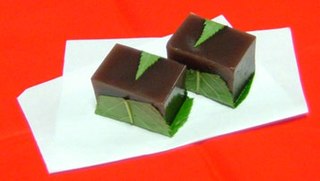 W
WAgar, or agar-agar, is a jelly-like substance, obtained from red algae.
 W
WAlginic acid, also called algin, is a polysaccharide distributed widely in the cell walls of brown algae that is hydrophilic and forms a viscous gum when hydrated. With metals such as sodium and calcium, its salts are known as alginates. It is a significant component of the biofilms produced by the bacterium Pseudomonas aeruginosa, a major pathogen found in the lungs of some people who have cystic fibrosis. The biofilm and P. aeruginosa have a high resistance to antibiotics, and are susceptible to inhibition by macrophages. Its colour ranges from white to yellowish-brown. It is sold in filamentous, granular, or powdered forms.
 W
WDental amalgam is a liquid mercury and metal alloy mixture used in dentistry to fill cavities caused by tooth decay. Low-copper amalgam commonly consists of mercury (50%), silver (~22–32%), tin (~14%), zinc (~8%) and other trace metals.
 W
WPer-Ingvar Brånemark was a Swedish physician and research professor, touted as the "father of modern dental implantology". The Brånemark Osseointegration Center (BOC), named after its founder, was founded in 1989 in Gothenburg, Sweden.
 W
WCalcium hydroxide (traditionally called slaked lime) is an inorganic compound with the chemical formula Ca(OH)2. It is a colorless crystal or white powder and is produced when quicklime (calcium oxide) is mixed, or slaked with water. It has many names including hydrated lime, caustic lime, builders' lime, slack lime, cal, or pickling lime. Calcium hydroxide is used in many applications, including food preparation, where it has been identified as E number E526. Limewater is the common name for a saturated solution of calcium hydroxide.
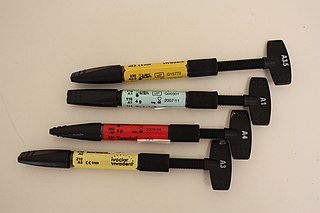 W
WDental composite resins are dental cements made of synthetic resins. Synthetic resins evolved as restorative materials since they were insoluble, of good tooth-like appearance, insensitive to dehydration, easy to manipulate and reasonably inexpensive. Composite resins are most commonly composed of Bis-GMA and other dimethacrylate monomers, a filler material such as silica and in most current applications, a photoinitiator. Dimethylglyoxime is also commonly added to achieve certain physical properties such as flow-ability. Further tailoring of physical properties is achieved by formulating unique concentrations of each constituent.
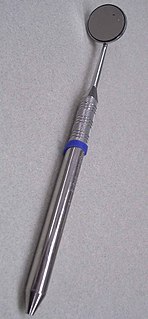 W
WDental instruments are tools that dental professionals use to provide dental treatment. They include tools to examine, manipulate, treat, restore, and remove teeth and surrounding oral structures.
 W
WDental porcelain is a dental material used by dental technicians to create biocompatible lifelike dental restorations, such as crowns, bridges, and veneers. Evidence suggests they are an effective material as they are biocompatible, aesthetic, insoluble and have a hardness of 7 on the Mohs scale. For certain dental prostheses, such as three-unit molars porcelain fused to metal or in complete porcelain group, zirconia-based restorations are recommended.
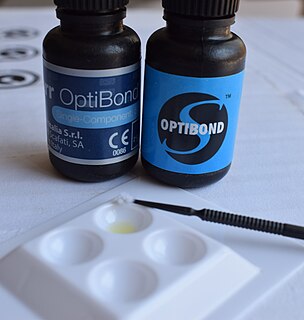 W
WAlso known as a "bonderizer" bonding agents are resin materials used to make a dental composite filling material adhere to both dentin and enamel.
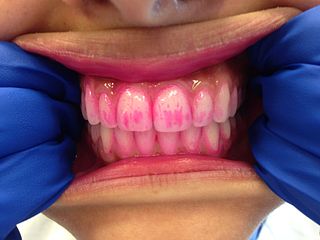 W
WDisclosing tablets are chewable tablets used to make dental plaque visible.
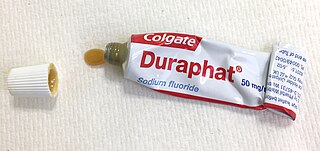 W
WFluoride varnish is a highly concentrated form of fluoride which is applied to the tooth's surface, by a dentist, dental hygienist or other health care professional, as a type of topical fluoride therapy. It is not a permanent varnish but due to its adherent nature it is able to stay in contact with the tooth surface for several hours. It may be applied to the enamel, dentine or cementum of the tooth and can be used to help prevent decay, remineralise the tooth surface and to treat dentine hypersensitivity. There are more than 30 fluoride-containing varnish products on the market today, and they have varying compositions and delivery systems. These compositional differences lead to widely variable pharmacokinetics, the effects of which remain largely untested clinically.
 W
WGold is a chemical element with the symbol Au and atomic number 79, making it one of the higher atomic number elements that occur naturally. In a pure form, it is a bright, slightly reddish yellow, dense, soft, malleable, and ductile metal. Chemically, gold is a transition metal and a group 11 element. It is one of the least reactive chemical elements and is solid under standard conditions. Gold often occurs in free elemental (native) form, as nuggets or grains, in rocks, in veins, and in alluvial deposits. It occurs in a solid solution series with the native element silver and also naturally alloyed with copper and palladium. Less commonly, it occurs in minerals as gold compounds, often with tellurium.
 W
WA dental impression is a negative imprint of hard (teeth) and soft tissues in the mouth from which a positive reproduction can be formed. It is made by placing an appropriate material in a stock or custom dental impression tray which is designed to roughly fit over the dental arches. Impression material is of liquid or semi-solid nature when first mixed and placed in the mouth. It then sets to become an elastic solid, leaving an imprint of person's dentition and surrounding structures of oral cavity.
 W
WA luting agent is an application of a dental cement connecting the underlying tooth structure to a fixed prosthesis. To lute means to glue two different structures together. There are two major purposes of luting agents in dentistry – to secure a cast restoration in fixed prosthodontics, and to keep orthodontic bands and appliances in situ.
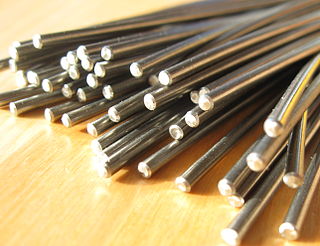 W
WNickel titanium, also known as Nitinol, is a metal alloy of nickel and titanium, where the two elements are present in roughly equal atomic percentages. Different alloys are named according to the weight percentage of nickel, e.g. Nitinol 55 and Nitinol 60. It exhibits the shape memory effect and superelasticity at different temperatures.
 W
WOil of clove, also known as clove oil, is an essential oil extracted from the clove plant, Syzygium aromaticum. Clove oil is commonly used in aromatherapy and for flavoring food and some medicines. Madagascar and Indonesia are the main producers of clove oil.
 W
WP11-4 is a synthetic, pH controlled self-assembling peptide used for biomimetic mineralization e.g. for enamel regeneration or as an oral care agent. P11-4 consists of the natural occurring amino acids Glutamine, Glutamic acid, Phenylalanine, Tryptophan and Arginine. The resulting higher molecular structure has a high affinity to tooth mineral. P11-4 has been developed and patented by The University of Leeds (UK). The swiss company credentis has licensed the peptide technology and markets it under the trade names including CUROLOX, REGENAMEL, and EMOFLUOR. They offer three products with this technology. As of June 2016 in Switzerland products are available with new Brand names from Dr. Wild & Co AG.
 W
WPoly(methyl methacrylate) (PMMA), also known as acrylic, or acrylic glass, as well as by the trade names Crylux, Plexiglas acrylic, Acrylite, Astariglas, Lucite, Perclax, and Perspex, among several others, is a transparent thermoplastic often used in sheet form as a lightweight or shatter-resistant alternative to glass. The same material can be used as a casting resin or in inks and coatings, among many other uses.
 W
WPolynoxylin is an antiseptic for local treatment of the skin and the mouth. It is a formaldehyde releasing antimicrobial polymer.